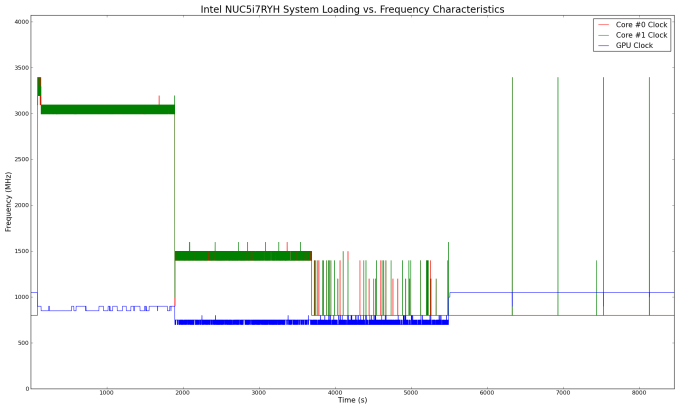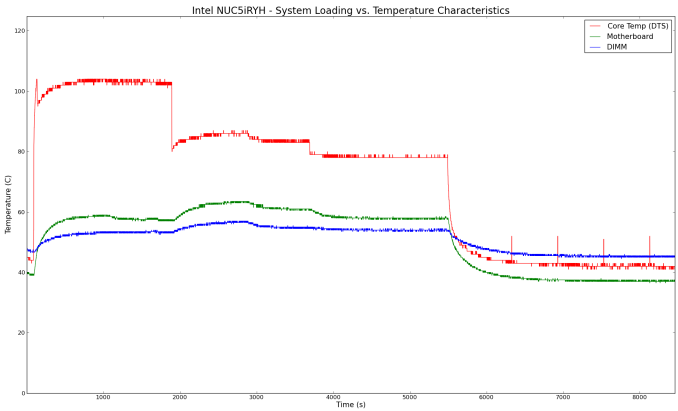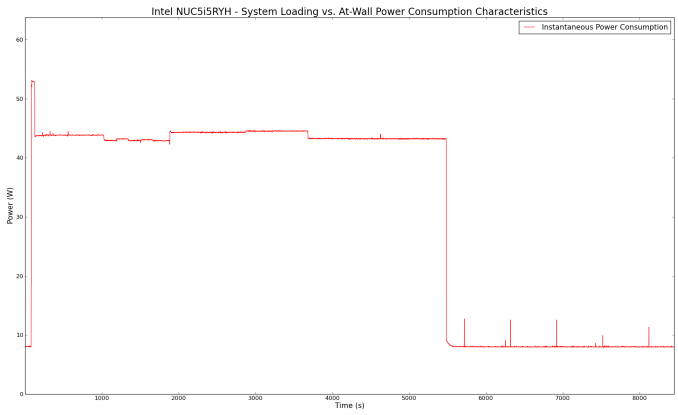Intel NUC5i7RYH Broadwell-U Iris NUC Review
by Ganesh T S on April 20, 2015 8:00 AM EST- Posted in
- Systems
- Intel
- HTPC
- NUC
- Broadwell-U
Power Consumption and Thermal Performance
The power consumption at the wall was measured with a 1080p display being driven through the HDMI port. In the graphs below, we compare the idle and load power of the Intel NUC5i7RYH with other low power PCs evaluated before. For load power consumption, we ran Furmark 1.12.0 and Prime95 v27.9 together. The numbers are not beyond the realm of reason for the combination of hardware components in the machine.


In the steady state, the clocks are managed in order to ensure that the at-wall power consumption stays within the limits of the thermal design's capabilities. As we will see further down, the unit can consume more than 55 W at the wall for short bursts before the thermal management kicks in.
Our thermal stress routine starts with the system at idle, followed by 30 minutes of pure CPU loading. This is followed by another 30 minutes of both CPU and GPU being loaded simultaneously. After this, the CPU load gets removed, allowing the GPU to be loaded alone for another 30 minutes. The various clocks in the system as well as the temperatures within the unit are presented below.
According to Intel's official specifications, the junction temperature of the Core i7-5557U is 105C. We find that pure CPU loading takes us close to it with turbo frequencies (3.4 GHz). However, before thermal throttling can kick in, the CPU cores revert to the rated operating frequency of 3.1 GHz. At that frequency, the cores have no trouble staying below the junction temperature.
The case of CPU and GPU getting loaded simultaneously is more interesting. The CPU cores run at 1.5 GHz and the GPU around 750 MHz. The temperature of the CPU package doesn't go above 85 C in this scenario. Obviously, we are not being thermally limited. The at-wall power consumption graph provides more insight.
The limiting factor on the performance / operating frequencies turns out to be the at-wall power consumption. With both CPU and GPU loaded simultaneously, the unit has a sustained power consumption of around 45 W, and we find that the number is similar for both the CPU-only and GPU-only scenarios.
On the whole the thermal design works well. As long as the limiting factors for the performance of the NUC are understood, the end users should not be in for any surprises.













66 Comments
View All Comments
ganeshts - Monday, April 20, 2015 - link
I can understand the issue for people who are following each and every review that is published here. On the other hand, many of our readers come from search results - say, someone searching on Google for 'Iris NUC review' - So, it is necessary for each review to be a 'standalone' piece ; I have published 10+ UCFF PC reviews in the last year or so. I would rather spend time writing about the actual benchmark results rather than thinking about 10 different ways to convey the same information.If you are a regular reader, the only item of interest in the introductory section would be the table listing the specs of the unit on a comparative basis. Feel free to skim over the introductory section and dive into the actual benchmark results if you are a regular reader.
keg504 - Monday, April 20, 2015 - link
The title for the DiRT Showdown benchmarks is "Tomb Raider" for some reason...ganeshts - Monday, April 20, 2015 - link
Thanks! Fixed ithlovatt - Monday, April 20, 2015 - link
@ganeshts Any chance of a Mac Mini review to see how it stacks up in the HTPC stakes? After all the Mac Mini is one of the founders of this form factor.milkod2001 - Monday, April 20, 2015 - link
i'll second that, please do review and comparison NUC vs Mac Mini if possible.zodiacfml - Monday, April 20, 2015 - link
After all the Core M review these days, 28 watts appeared a performance monster at first glance.Yet, this is no Quad Core compared to previous similarly priced NUC. Not impressed.
meacupla - Monday, April 20, 2015 - link
If you're talking about that Brix Pro, that thing was a beast and it consumes about 2x the power that this NUC does.zodiacfml - Tuesday, April 21, 2015 - link
True, but these devices are plugged in. For a notebook, I might reconsider.Pork@III - Monday, April 20, 2015 - link
Weak is weak, if you will, and it names NUClear.meacupla - Monday, April 20, 2015 - link
If it said "NUClear" on the package, I would totally expect it to contain an R9 290X and subsequently melt down to a smouldering pile of plastic, silicon and PCB the moment it is subjected to ground breaking benchmarks.